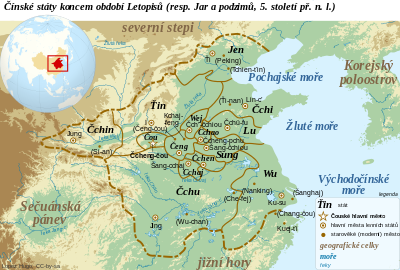Stát Sung

 | |||||||
|---|---|---|---|---|---|---|---|
| STAROVĚKÁ ČÍNA | |||||||
| 3 vznešení a 5 vladařů | |||||||
| Dynastie Sia 2100–1600 př. n. l. | |||||||
| Dynastie Šang 1600–1046 př. n. l. | |||||||
| Dynastie Čou 1045–256 př. n. l. | |||||||
| Západní Čou | |||||||
| Východní Čou | |||||||
| Období Jar a podzimů | |||||||
| Období válčících států | |||||||
| CÍSAŘSKÁ ČÍNA | |||||||
| Dynastie Čchin 221 př. n. l.–206 př. n. l. | |||||||
| Dynastie Chan 206 př. n. l.–220 n. l. | |||||||
| Západní Chan | |||||||
| Dynastie Sin | |||||||
| Východní Chan | |||||||
| Období tří říší 220–280 | |||||||
| Wej, Šu & Wu | |||||||
| Dynastie Ťin 265–420 | |||||||
| Západní Ťin | 16 Království 304–439 | ||||||
| Východní Ťin | |||||||
| Severní & Jižní dynastie 420–589 | |||||||
| Dynastie Suej 581–618 | |||||||
| Říše Tchang 618–907 | |||||||
| ( X Wu Ce-tchien 690–705 ) | |||||||
| 5 dynastií & 10 říší 907–960 | Dynastie Liao 907–1125 | ||||||
| Dynastie Sung 960–1279 | |||||||
| Severní Sung | Z. Sia | ||||||
| Jižní Sung | Ťin | ||||||
| Dynastie Jüan 1271–1368 | |||||||
| Dynastie Ming 1368–1644 | |||||||
| Říše Čching 1644–1911 | |||||||
| MODERNÍ ČÍNA | |||||||
| Republika 1912–1949 | |||||||
| Spor o Čínu ... | |||||||
| Čínská lidová republika 1949–současnost | Čínská republika (Tchaj-wan) 1945–současnost | ||||||
Související články Časová osa čínských dějin | |||||||
Stát Sung (čínsky: pinyin Sòng, znaky 宋國) byl jeden z čínských států existujících v období jar a podzimů (722-481 př. n. l.) a období válčících států (481-212 př. n. l.).
Ležel na východě dnešního Che-nanu. Založil ho v 11. století př. n. l. potomek svržené dynastie Šang. Hlavním městem bylo Šang-čchiou (čínsky: pinyin Shāngqiū, znaky 宋國). Po určitou dobu i Po-čou.[1] Stát zanikl roku 286 př. n. l., když byl pohlcen královstvím Čchin.
Odkazy
Reference
V tomto článku byl použit překlad textu z článku Song (state) na anglické Wikipedii.
Externí odkazy
 Obrázky, zvuky či videa k tématu Stát Sung na Wikimedia Commons
Obrázky, zvuky či videa k tématu Stát Sung na Wikimedia Commons
Média použitá na této stránce
"Departure Herald", 26 m (85 ft) in length, from the Chinese Xuande reign period (1425-1435 AD); the painting shows the emperor's large procession heading towards the imperial tombs of the Ming emperors located roughly 50 km north of the capital Beijing. This painting is usually paired with another panoramic painting called "Return Clearing", 30 m (98 ft) in length, which shows the emperor returning to the capital from the tombs by river boat. From Paludan's source listed below, this passage describes a particular scene of this painting: "Detail of a silk scroll, The Emperor's Approach, showing the luxury in which the emperor Xuande travelled. Elephants were kept in the imperial elephant stables until around 1900 and were often used for ceremonial occasions, such as the emperor's visits to the Temple of Heaven. Here, however, the large number of horsemen accompanying the emperor's carriage suggests that the emperor was on a much longer journey in the countryside." Paludan, Ann. (1998). Chronicle of the Chinese Emperors: the Reign-by-Reign Record of the Rulers of Imperial China. London: Thames & Hudson Ltd. ISBN 0500050902. Page 177.
Autor:
- Chinese plain 5c. BC-en.svg: Yug
- derivative work: Jann
Mapa severočínské nížiny, 5. století př. n. l. (konec období Letopisů, počátek období Válčících států)

